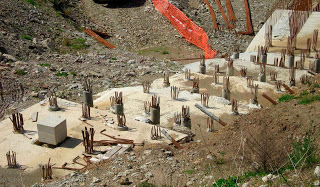A pile is a long slender foundation member, made either of timber, structural steel or concrete which might be cast-in-situ or driven and acts as a structural member to transfer the load of the structure to a required depth in deep foundations carrying a load which may be vertical or lateral or lateral plus vertical
 |
| Pile Foundation |
Uses of Piles
As far as deep foundations are concerned there are no. of types of deep foundations and pile foundation is among one of them; uses of Pile Foundation depends on the type of pile used, the intended function for which the pile is used, the load which is to be applied on the pile and the type of material which is used for the construction of the pile;
The following are the uses of piles;
a) End Bearing or Compressive Strength
Sometimes we use the piles to achieve the required compressive strength in the soft soil; in that case we use the piles to transfer the load through that soft soil to a suitable bearing stratum by using the end bearing or toe bearing property of the pile
b) Scour Depth:
To build a structure within the water and on the water river or canal bed; we have to build the foundation through the river bed and within the scour depth. To learn more on what is scouring? What is scour depth and how to calculate scour
click here. For River Ravi in Pakistan the scour depth is 30 to 35 cm below the bed. In these sorts of situations if we go for shallow foundation we might have to use coffer dam or some diversion which is very uneconomical.
c) Tension or Uplift:
Piles are usually used to carry compressive nature of load through tip bearing or end bearing; but in case of tall structures or like towers there might be tension that must be resisted by piles. For example for a tower carrying high power transmission lines the thrust of wind might produces over turning that must be resisted by the tension piles; other options include use of deep foundation or thick raft which is sometimes uneconomical.
d) Vibration Control
For foundation of buildings supporting vibrating equipments like Turbines and silos etc where the vibrations is significant and might cause failures as well; there are two options there you might go for the massive block to absorb the vibrations or you can use the deep foundations and same that the massive block is very uneconomical.
e) Compaction Piles:
Sometimes the piles are driven in a weaker strata of soil to increase the bearing capacity of the soil those piles are called compaction piles; and thus by using compaction piles we can increase the bearing capacity of the soil.
f) Rapid Construction
To tackle or to avoid any problem relating to soils deep foundations and specially piles are a very good option when the time schedule is very tough. They are rapid to construct and not difficult to design as well.
incoming keywords:
what is pile foundation types of pile,what is pile foundation construction,what is pile foundation used for,types of pile foundation
,what is raft foundation,define pile foundation,pile cap foundation,
difference between shallow foundation and deep foundation













hhaaaaaaa……
hhaaaaaaa……